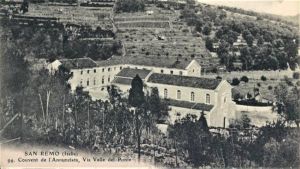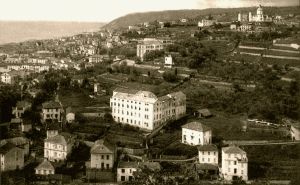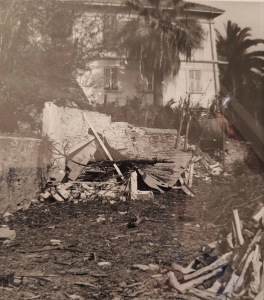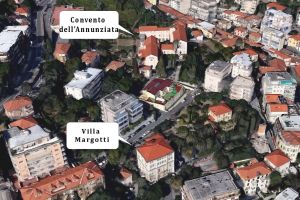A Convent with a very troubled life
There are no certain documents on the origins of the Convent.
It would appear that this structure was originally used as the Convent of the Friars Minor Observant of the Franciscans (Friars Zoccolanti).
The denunciation of heresy against a friar, certain Antonio del Bugnato in 1588 certifies that the convent was already active in the 16th century.
(From an essay by Rossella Masper on the Western Ligurian Inquisition in the 16th and 17th centuries). Towards the end of the 19th century it appears that it first belonged to the Annunziades Sisters, founded by Blessed Maria Vittoria Strata (founder also of the order of the Turchine).
Towards the end of the 19th century it appears that it first belonged to the Annunziades Sisters, founded by Blessed Maria Vittoria Strata (founder also of the order of the Turchine).
Only a few elderly and sick Franciscan friars lived there.  In the meantime, a French nun, Helene de Chappotin de Neuville (1839-1904), already a Poor Clare in Nantes in 1864, before leaving as a missionary for the Antilles, on the island of Guadeloupe, taking the name of Mary of the Passion, obtained authorisation from Pope Pius IX in 1877, established the Congregation of the Franciscan Missionary Sisters of Mary for the care of the sick and needy Sisters and for the Protection of the Young.
In the meantime, a French nun, Helene de Chappotin de Neuville (1839-1904), already a Poor Clare in Nantes in 1864, before leaving as a missionary for the Antilles, on the island of Guadeloupe, taking the name of Mary of the Passion, obtained authorisation from Pope Pius IX in 1877, established the Congregation of the Franciscan Missionary Sisters of Mary for the care of the sick and needy Sisters and for the Protection of the Young.
The Sisters were also called "of Guadeloupe" because their foundress resided and died on the island of the same name.
In 1882 this congregation was aggregated to the Order of Friars Minor Franciscans.
At the end of the 19th century (or beginning of the 20th century) the convent of Sanremo was bought by the French Franciscan Friars Minor, who were forced to leave France for political reasons.
The friary was paid 70,000 lire and part of the cost was advanced by the above-mentioned Sister Maria della Passione who died shortly afterwards, on 15th November 1904.  On 16th April 1917 Mère Marie de la Rédemption of the Congregation bought the Villa Margotti in Via G. Giusti.
On 16th April 1917 Mère Marie de la Rédemption of the Congregation bought the Villa Margotti in Via G. Giusti.
The new community shares the wooden chapel of the Guadeloupe; the two upper floors of the house are used for the embroidery workshops and provide work for 35 embroiderers.
In 1939 the last two Franciscan Fathers who resided in the friary died and the Father General asked Mère M. Marguerite du Sacrée Coeur, Superior General of the Franciscan Missionary Sisters, to buy the friary. Having taken possession of the friary, the new community shared with the guests of Villa Margotti a wooden chapel of Guadalupe which was placed in the friary garden.
In 1950 they organised the catechesis in the parish of San Martino, notoriously held by the Franciscan Fathers.
A piece of land was purchased in 1948 for the construction of a nursery school, which was inaugurated in 1960.
The same premises also housed a nursery school between 1961 and 1962.
The Sisters of Guadeloupe dedicated themselves to catechesis in various parishes, assisting young people from 15 to 22 years of age by organising a cutting and sewing school which at the end of the course awarded a regular diploma.
Since 1969 Villa Margotti became a paid accommodation for groups of passers-by. For this purpose the old laundry, which takes the name of St. Joseph, has also been renovated.
Some places are always reserved for the Opera per la Protezione della Giovane four beds are intended for the free reception of poor people. Since 1970, with the title of "Fraternità di Poggio", they dedicated themselves to the spiritual assistance of the guests of Casa Serena, an experience that ended in 1991.
Since 1970, with the title of "Fraternità di Poggio", they dedicated themselves to the spiritual assistance of the guests of Casa Serena, an experience that ended in 1991.
A renovation of the Guadeloupe house was carried out in 1971 to preserve the memories of Mary of the Passion.
Among the many activities of the Franciscan Sisters it is recalled that, in addition to those mentioned above, they provided voluntary assistance at the Prisons, collaborating with other services: Secretariat of the Archiepiscopal Curia, assistance for the recovery of drug addicts, and Diocesan Family Consultatory.
At first, in 1976, Villa Margotti was rented to S.I.P. (today TELECOM) which renewed the contract three times.
Subsequently, in 1980 the premises of the nursery school were rented to the Municipality of Sanremo; however, a priest ran the school and a Franciscan woman continued to look after the children together with the lay staff.
Finally, the premises of the Nursery School were definitively sold to the Municipality of Sanremo which then, in 2001, rented Villa Margotti, making it the headquarters of the Town Police Headquarters (today the Local Police).
The Margottina, which was used for the reception of passing nuns, is occupied by the Judge's offices for conjugal cases.
At present, in the original Convent we believe that very few or perhaps none of the nuns have remained as several of them, over the years, have been recalled to the central house in Rome.
(sources: notes from WEB searches; personal images)




